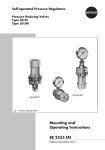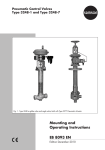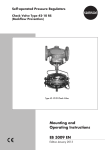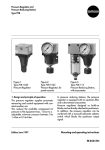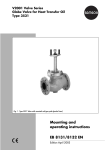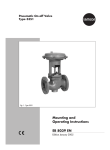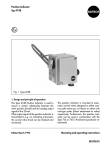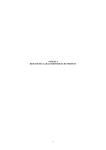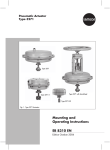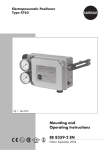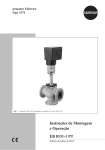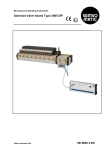Download Mounting and Operating Instructions EB 8227 EN
Transcript
Pneumatic Control Valve Type 3331/BR 31a Special version Type 3331/3278 Type 3331 Butterfly Valve Fig. 1 · Type 3331/BR 31a (below) and Type 3331/3278 (top) Mounting and Operating Instructions EB 8227 EN Edition July 2004 Contents Contents Page 1 Design and principle of operation . . . . . . . . . . . . . . . . . . . 4 2 2.1 2.1.1 2.1.2 2.2 2.3 2.4 Installation . . . . . . . . . . . . . . . . . . Assembling butterfly valve and rotary actuator . Type 3331-BR 31a, Type SRP . . . . . . . . . Type 3331/3278 . . . . . . . . . . . . . . Mounting position . . . . . . . . . . . . . . Test connection . . . . . . . . . . . . . . . . Loading pressure connection . . . . . . . . . 3 3.1 Operation . . . . . . . . . . . . . . . . . . . . . . . . . . . . . . . 8 Changing the fail-safe position . . . . . . . . . . . . . . . . . . . . . 8 4 4.1 4.2 Maintenance . . . . . . . . . . . . . . . . . . . . . . . . . . . . . . 9 Packing . . . . . . . . . . . . . . . . . . . . . . . . . . . . . . . . 9 Removing the butterfly valve. . . . . . . . . . . . . . . . . . . . . . . 9 5 Customer inquiries . . . . . . . . . . . . . . . . . . . . . . . . . . 10 . . . . . . . . . . . . . . . . . . . . . . . . . . . . . . . . . . . . . . . . . . . . . . . . . . . . . . . . . . . . . . . . . . . . . . . . . . . . . . . . . . . . . . . . . . . Note: Non-electrical actuators and valves do not have their own potential ignition source according to the risk assessment in the rare incident of an operating fault, corresponding to EN 13463-1: 2001 paragraph 5.2, and therefore do not fall within the scope of the European Directive 94/9/EC. Refer to paragraph 6.3 of EN 60079-14:1977 VDE 0165 Part 1 concerning connection to equipotential bonding system. 2 EB 8227 EN 6 6 6 7 8 8 8 Safety instructions General safety instructions 4 The control valve may only be mounted, started up or serviced by fully 4 4 4 trained and qualified personnel, observing the accepted industry codes and practices. Make sure employees or third persons are not exposed to any danger. All safety instructions and warnings in these mounting and operating instructions, particularly those concerning assembly, start-up and maintenance, must be observed. The control valves fulfill the requirements of the European Pressure Equipment Directive 97/23/EC. Valves with a CE marking have a declaration of conformity that includes information about the applied conformity assessment procedure. The corresponding declaration of conformity can be viewed and downloaded on the Internet at http://www.samson.de. For appropriate operation, make sure that the control valve is only used in areas where the operating pressure and temperatures do not exceed the operating values which are based on the valve sizing data submitted in the order. The manufacturer does not assume any responsibility for damage caused by external forces or any other external influence! Any hazards which could be caused in the control valve by the process medium, operating pressure, signal pressure or by moving parts are to be prevented by means of the appropriate measures. Proper shipping and appropriate storage of the control valve are assumed. Caution! 4 For installation and maintenance work on the valve, make sure the relevant 4 section of the pipeline is depressurized and, depending on the process medium, drained as well. If necessary, allow the control valve to cool down or warm up to reach ambient temperature prior to starting any work on the valve. Prior to performing any work on the valve, make sure the supply air and control signal are disconnected or blocked to prevent any hazards that could be caused by moving parts. EB 8227 EN 3 Design and principle of operation 1 Design and principle of opera- Fail-safe positions: tion The fail-safe position of the control valve The pneumatic control valve consists of a Type 3310 Butterfly Valve and either a Pfeiffer Type BR 31a Pneumatic Actuator or a SAMSON Type 3278 Pneumatic Actuator. The control valve is primarily intended for throttling or on-off service in the process engineering industry and industrial applications. It is suitable for liquids, vapors, and gases with temperatures from −10 to +400 °C and with nominal pressures from PN 10 to 40. The butterfly valve in nominal sizes DN 100 to 400 can be designed depending on the application with a swing-through or angle-seated/low-noise butterfly disc. The version used can be identified by a symbol on the butterfly valve’s nameplate. The process medium flows through the butterfly valve. The signal pressure acting on the pneumatic actuator determines the position (opening angle) of the butterfly disc (8) and the flow rate across the free area between disc and body (1). The shaft is sealed by a packing (5). The actuator motion is transmitted over a squareended shaft. In Type 3331/3278, a shaft with feather key (4.1) is used to transmit the motion from the actuator to the shaft. 4 EB 8227 EN upon failure of the supply air is determined by the version of Type 3331/BR 31a (single-acting Type SRP) or depending on how the rotary actuator is attached for Type 3331/3278. Valve CLOSED without supply air The actuator springs close the valve when the pressure is relieved from the rotary actuator or when the supply air fails. The valve is opened opposing the force of the actuator springs as the signal pressure increases. Valve OPEN without supply air The actuator springs open the valve when the pressure is relieved from the rotary actuator or when the supply air fails. The valve is closed opposing the force of the actuator springs as the signal pressure increases. Design and principle of operation Pfeiffer Type BR 31a Actuator Type 3278 Actuator Swing-through disc 1 2 3 4 4.2 5 6 7 8 Valve body Gland flange Yoke Shaft Feather key Packing Spring Tapered pins Butterfly disc 9 10 12 12.1 12.2 13 13.1 13.2 Angle-seated/ low-noise disc Internal bearing Plug Type BR 31a Actuator Stop Stop screw Type 3278 Actuator Stop screw Stop screw Fig. 2 · Sectional diagram of the butterfly valve EB 8227 EN 5 Installation 2 Installation 2.1 Assembling butterfly valve and rotary actuator Note! The butterfly valve may be used for throttling or on-off service. For on-off service, the opening angle must be set to 90° (70° with angle-seated discs) using the stop screws. For throttling service, the opening angle must be set to 70° using the stop screws. 2.1.1 Type 3331-BR 31a, Type SRP If the valve and actuator have not been preassembled by the manufacturer, proceed as follows: Note! In the standard actuator version (SRP = single acting with spring-return mechanism) the springs turn clockwise. Should the springs turn counterclockwise, this must be specified on ordering the actuator. The rotary actuator can be mounted either vertically or horizontally on the valve and may be positioned at 90° around the valve as required by the on-site conditions over a square-end shaft. 6 EB 8227 EN Valve CLOSED without supply air 1. Place disc (8) in closed position (0° angle of rotation). 2. Fasten yoke (3) with 2 or 4 screws depending on the nominal size of the valve to the flange of the shaft (4). 3. Place shaft adapter (if required) onto the shaft. Slide actuator over adapter (or shaft) and fasten to the yoke using four screws. 4. Turn the stop screw (12.1 or 12.2, depending on the direction of rotation) until the valve is completely closed. Align the markings on the shaft with the markings on the gland flange. 5. Secure the position of the stop screw with its lock nut. 6. Apply a signal pressure to match the number of springs (see nameplate) to the loading pressure connection. 7. Turn the other stop screw until the disc reaches the opening angle of 90° or 70°. 8. Secure the position of the stop screw with its lock nut. Valve OPEN without supply air 1. Place disc (8) in open position (90° angle of rotation). 2. Fasten yoke (3) with 2 or 4 screws depending on the nominal size of the valve to the flange of the shaft (4). 3. Place shaft adapter (if required) onto the shaft. Slide actuator over adapter (or shaft) and fasten to the yoke (3) using four screws (3.1). Installation 4. Turn the stop screw (12.1 or 12.2, depending on the direction of rotation) until the valve is completely open at 90°. Align the markings on the shaft with the markings on the gland flange. 5. Secure the position of the stop screw with its lock nut. 6. Apply a signal pressure to match the number of springs (see nameplate) to the loading pressure connection. 7. Turn the other stop screw until the valve is completely closed. Align the markings on the shaft with the markings on the gland flange. 8. Secure the position of the stop screw with its lock nut. 2.1.2 Type 3331/3278 If the valve and actuator have not preassembled by the manufacturer, the actuator is mounted either to the flange 1 or 2 depending on the fail-safe position. The digit 1 or 2 is cast on the flange on the corresponding side of the body. The rotary actuator can be mounted either vertically or horizontally on the valve and may be positioned at 90° around the valve as required by the on-site conditions over four feather key grooves arranged in stages of 90° around the actuator shaft. Valve CLOSED without supply air 1. Undo both stop screws (13.1 and 13.2) at the actuator. Rescrew stop screw (13.2) to the point where the grooves of the actuator shaft are positioned vertically or horizontally to the actuator axis. 2. Place disc (8) in closed position (0° angle of rotation). 3. Fasten yoke (3) with 2 or 4 screws depending on the nominal size of the valve to the flange of the shaft (4). 4. Slide actuator over shaft (4) and fasten tight at yoke (3) using the four screws. 5. Undo stop screw (13.2) again. 6. Turn the stop screw (13.2) until the valve is completely closed. Align the markings on the shaft with the markings on the gland flange. 7. Apply the signal pressure required for the spring range (see nameplate) to achieve the opening position. 8. Turn the stop screw (13.1) until the disc (8) reaches the open position (90° or 70° angle of rotation). 9. Secure the position of both stop screws with their lock nuts. Valve OPEN without supply air 1. Undo both stop screws (13.1 and 13.2) at the actuator. Rescrew stop screw (13.1) to the point where the grooves of the actuator shaft are positioned vertically or horizontally to the actuator axis. 2. Place disc (8) in open position (90° angle of rotation). EB 8227 EN 7 Installation 3. Fasten yoke (3) with 2 or 4 screws depending on the nominal size of the valve to the flange of the shaft (4). 4. Slide actuator over shaft (4) and fasten tight at yoke (3) using the four screws. 5. Undo stop screw (13.1) again. 6. Apply the signal pressure required for the spring range (see nameplate) to achieve the closed position. 7. Turn the stop screw (13.1) until the valve is completely closed. Align the markings on the shaft with the markings on the gland flange. 8. Disconnect the signal pressure. 9. Turn the stop screw (13.2) until the disc (8) reaches the open position (90° or 70° angle of rotation). 10. Secure the position of both stop screws with their lock nuts. 2.2 Mounting position The butterfly valve may be installed vertically or horizontally in the pipeline. However, the following points must be observed for the direction of flow: Mount the butterfly valve in the pipeline so that the lower half of the disc opens towards the direction of the flow. This helps prevent any dirt deposits collecting which could prevent the disc from opening. Butterfly valves with angle-seated/low-noise (streamlined) discs must be mounted without exception with the direction of flow indicated by the arrow on the valve body. On mounting the valve between flanges in the pipeline, place the disc in its closed position. Take care not to damage the facings. On tightening the flange bolts, make sure that 8 EB 8227 EN the flat gaskets are compressed evenly. The butterfly disc must move without any restrictions when the valve is installed in the pipeline. 2.3 Test connection Butterfly valves with a test connection to monitor the packing (recognizable by a label and hexagonal screw plug), must be equipped with a suitable leakage indicator such as a contact pressure gauge, outlet into an open receptacle or sight-glass. 2.4 Loading pressure connection The loading pressure connection of small rotary actuators is designed as a tapped G 1/8 hole and G 1/4 in large actuators. Connection according to VDI/VDE 3845 allows also the attachment of solenoid valves (e.g. Type 3963) or a limit switch with or without solenoid valve (e.g. Type 3776/ 3777). In conjunction with SAMSON positioners, suitable accessories are available for connection. Operation 3 Operation 3.1 Changing the fail-safe position 4 Note! Before performing any maintenance work on the control valve, depressurize the concerned section of the plant and drain the process medium, if necessary. Wait until the medium has cooled down, if necessary. We recommend removing the valve from the pipeline. Caution! On performing any work on the valve body, first shut off the supply pressure, disconnect the supply pressure line and remove the actuator. The fail-safe position of the Type 3278 Actuator can be changed from “Valve CLOSED without supply air” to “Valve OPEN without supply” or vice versa. To proceed, mount the rotary actuator on the other side. Refer to section 2.1.2. The pistons of the Type BR 31a Actuator (SRP) must be installed in the reverse direction in the actuator. Note! Refer to the Mounting and Operating Instructions of the rotary actuator used for further details such as changing the spring range to achieve other actuator torques. Maintenance 4.1 Packing Packing versions for use with temperature ranges up to 220 °C are self-adjusting. Packing suitable for higher temperatures up to 450 °C can be adjusted. This packing must be adjusted carefully on starting up the plant by carefully tightening the gland flange (2). 4.2 Removing the butterfly valve Note! On removing the butterfly valve from the pipeline, make sure that the disc is in the closed position. EB 8227 EN 9 Customer inquiries 5 Customer inquiries Please submit the following details: 4 Order number 4 Type designation, model number, nominal size and version of the valve 4 Pressure and temperature of the process medium 4 Flow rate in m3/h 4 Bench range (spring range) of the actuator 4 Installation drawing Dimensions and weights Refer to the Data Sheet T 8227 EN for the dimensions and weights of the various valve versions. 10 EB 8227 EN EB 8227 EN 11 EB 8227 EN S/Z 2004-10 SAMSON AG ⋅ MESS- UND REGELTECHNIK Weismüllerstraße 3 ⋅ 60314 Frankfurt am Main ⋅ Germany Phone +49 69 4009-0 ⋅ Fax +49 69 4009-1507 Internet: http://www.samson.de












